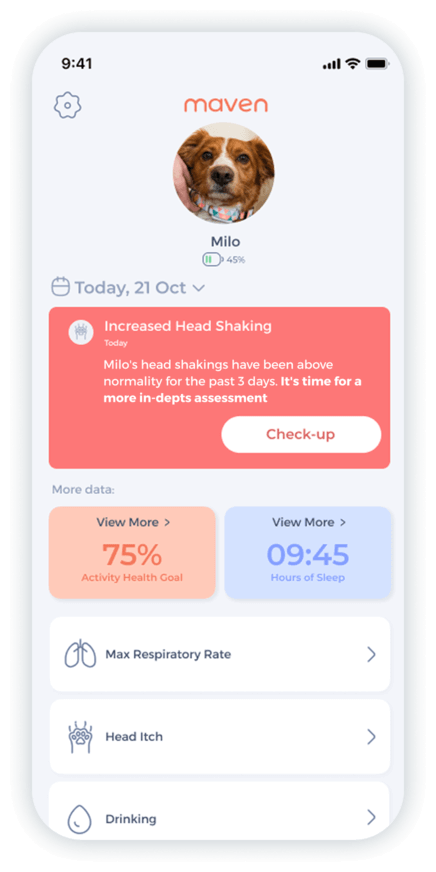“Why Is My Dog Shaking?” – Causes, Symptoms & When To Worry
If you’ve ever asked yourself, “Why is my dog shaking?”, you’re not alone.
Shaking or trembling is common behavior in dogs, but it can be distressing for pet parents to witness, especially when the cause is unclear.
Understanding the potential causes of shaking and when to seek veterinary care is crucial to your dog’s well-being. This is where tools like the Maven Pet smart collar can provide valuable support.
Maven Pet monitors your dog’s behavior consistently, tracking signs such as head shaking, decreased activity, and restlessness. These insights can help detect potential health issues early.
In this article, we will explore the common and medical reasons behind shaking, what symptoms to look for, and how Maven Pet’s innovative features empower you to ensure your dog’s best care.
- Shaking is common in dogs, often linked to non-medical reasons like cold weather or excitement.
- Persistent shaking may indicate serious health issues, including neurological disorders or infections.
- Maven Pet's smart collar helps track dog behavior, providing insights for early detection of health problems.
- Creating a calming environment and monitoring changes can effectively address a shaking dog's discomfort.
Common Reasons for Shaking in Dogs
Before jumping to medical conclusions, it’s important to recognize that many cases of shaking are due to non-medical reasons. These causes for shaking in dogs are often situational and can be resolved with simple adjustments.
Cold or Chilly Weather
Dogs shake to generate heat when they’re cold. This natural response is more common in small breeds, short-haired dogs, or pets exposed to low temperatures for extended periods.
If you notice your dog shivering during cold weather, consider providing extra warmth. A cozy blanket or heated dog pad and limiting time spent outdoors can make a significant difference.
Fear, Anxiety, or Excitement
Emotional triggers like fear, anxiety, or even excitement can cause your dog to shake. For instance, dogs often tremble during thunderstorms, fireworks, or visits to the vet.
Similarly, some dogs may shake when they’re overly happy or excited, such as during playtime or when greeting loved ones after an absence.
To address shaking due to fear or anxiety, create a safe and calming environment for your dog.
Why Is My Dog Trembling and Shaking?

If your dog’s shaking persists, occurs suddenly, or is accompanied by other symptoms, medical conditions could be at play. Seeking an answer to the question, “Why is my dog trembling and shaking?” is an essential step in exploring potential health-related causes.
Ear Infections (Otitis)
One of the most common reasons for head shaking in dogs is an ear infection. Infections cause discomfort, leading to excessive head shaking, scratching, and even balance issues in severe cases. You might notice redness, swelling, or discharge from the ear as additional signs.
Maven Pet’s monitoring system can help by tracking increased head shaking and scratching patterns, alerting you to seek veterinary care before the infection worsens.
Neurological Disorders
Conditions affecting the nervous system, such as epilepsy or tremor syndrome, can manifest as uncontrollable shaking or seizures.
Neurological-related trembling is usually more severe and may be accompanied by other signs such as stiffness, lack of coordination, or prolonged episodes of shaking.
If you suspect a neurological issue, it’s crucial to take your pet to the vet as quickly as possible.
Pain or Injury
Dogs often respond to pain or injury by shaking. In these cases, shaking may be localized or occur alongside other signs like limping, whining, or reluctance to engage in usual activities.
Monitoring your dog’s activity and behavior over time, as Maven Pet allows, can provide valuable data regarding whether their discomfort is improving or persisting.
Toxins or Poisoning
Shaking can also be a symptom of poisoning. Ingesting harmful substances such as chocolate, certain houseplants, pesticides, molds, or medications not meant for dogs can cause severe trembling, vomiting, drooling, or seizures.
If you suspect your dog has been exposed to toxins, contact your vet or a pet poison hotline immediately.
Low Blood Sugar (Hypoglycemia)
Hypoglycemia is highly common in small breeds, puppies, or dogs with certain medical conditions. Shaking, weakness, and lethargy are typical symptoms of low blood sugar. Feeding your dog a small meal can help temporarily stabilize their glucose levels, but persistent symptoms require veterinary intervention.
Infections
Infections like distemper (a contagious disease caused by the canine distemper virus), can cause shaking, among other symptoms. Dogs with distemper often exhibit fever, lethargy, and nasal discharge.
What Do Tremors Look Like in Dogs?

Tremors are different from normal shaking. While shaking might occur in response to a stimulus like cold or excitement, tremors in dogs are often involuntary and prolonged.
Keep an eye out for these signs as they may indicate your dog has tremors:
- Persistent or severe shaking without an obvious cause.
- Loss of coordination, making it difficult to stand or walk.
- Shaking and symptoms like vomiting, lethargy, or a change in behavior.
Tremors can indicate underlying issues that require quick medical intervention, such as neurological disorders or toxic exposure.
You can rely on Maven Pet’s monitor to help differentiate between occasional shaking and patterns that suggest a more serious problem thanks to its tracking feature and AI capabilities.
“I got the Maven sensor for my 14-year-old Chihuahua mix with heart and trachea issues. It gave me back peace of mind – I can track her RRR, BPM, drinking, and activity anytime and know instantly if something’s wrong. Highly recommend!”

★★★★★
Chiara De Luca
Titti
How Maven Pet Helps Detect Shaking-Related Issues

Maven Pet is a cutting-edge solution focused on pet wellness that helps you monitor your dog’s health and behavior. It’s the best ally you could ask for to help you find the answer to “Why is my dog shaking?”
This device is a game-changer when it comes to making sure your pet is feeling well thanks to its advanced features:
- Activity Monitoring: Identifies decreases in activity or signs of lethargy that could indicate illness or discomfort.
- Night Restlessness Tracking: Detects changes in nighttime behavior, often caused by pain or anxiety.
- Symptom Logging: This allows you to document appetite changes, unusual behaviors, or other symptoms for a comprehensive health profile.
- AI-Vet Integration: Combines your observations with veterinary data to provide actionable insights and recommendations.


Monitor heart rate, respiratory rate, activity & rest, drinking, itch behavior.
Maven Pet’s monitor tracks your dog’s activity 24/7 while learning about their usual activity and rest routines to identify changes later.
How to Calm a Shaking Dog

Calming a shaking dog requires understanding the cause and addressing their immediate needs for comfort and security. Here are some effective strategies:
- Provide Warmth: if your dog is cold, provide blankets and heated pads to make them more comfortable. You can also snuggle them to soothe them.
- Create a Stress-Free Environment: turn off loud sounds, make them feel safe, and dim the lights to create a cozy and quiet spot.
- Monitor and Track Behavior: tools like Maven Pet’s Health Monitor can signal changes in your dog’s activity and behavior, which helps you understand if there is something off regarding their well-being.
Final Notes

Dogs shake for a variety of reasons, from being cold or anxious to facing serious health challenges.
Understanding the potential causes and monitoring your dog’s behavior is the best way to find answers to the question “Why is my dog shaking?”
Tools like the Maven Pet smart collar simplify this process, offering real-time insights into your dog’s health. By tracking behaviors such as head shaking, restlessness, and decreased activity, Maven Pet helps you detect problems early.
Explore Maven Pet today to ensure your dog’s health is always a priority.
Maven Pet focuses on improving the quality of life of our pets with technology, using artificial intelligence (AI) to enable proactive pet care. By accurately collecting and monitoring pet data 24/7 and flagging any irregularities, Maven Pet empowers pet parents and veterinarians to stay ahead of potential health issues, ensuring the well-being and longevity of our beloved companions.




